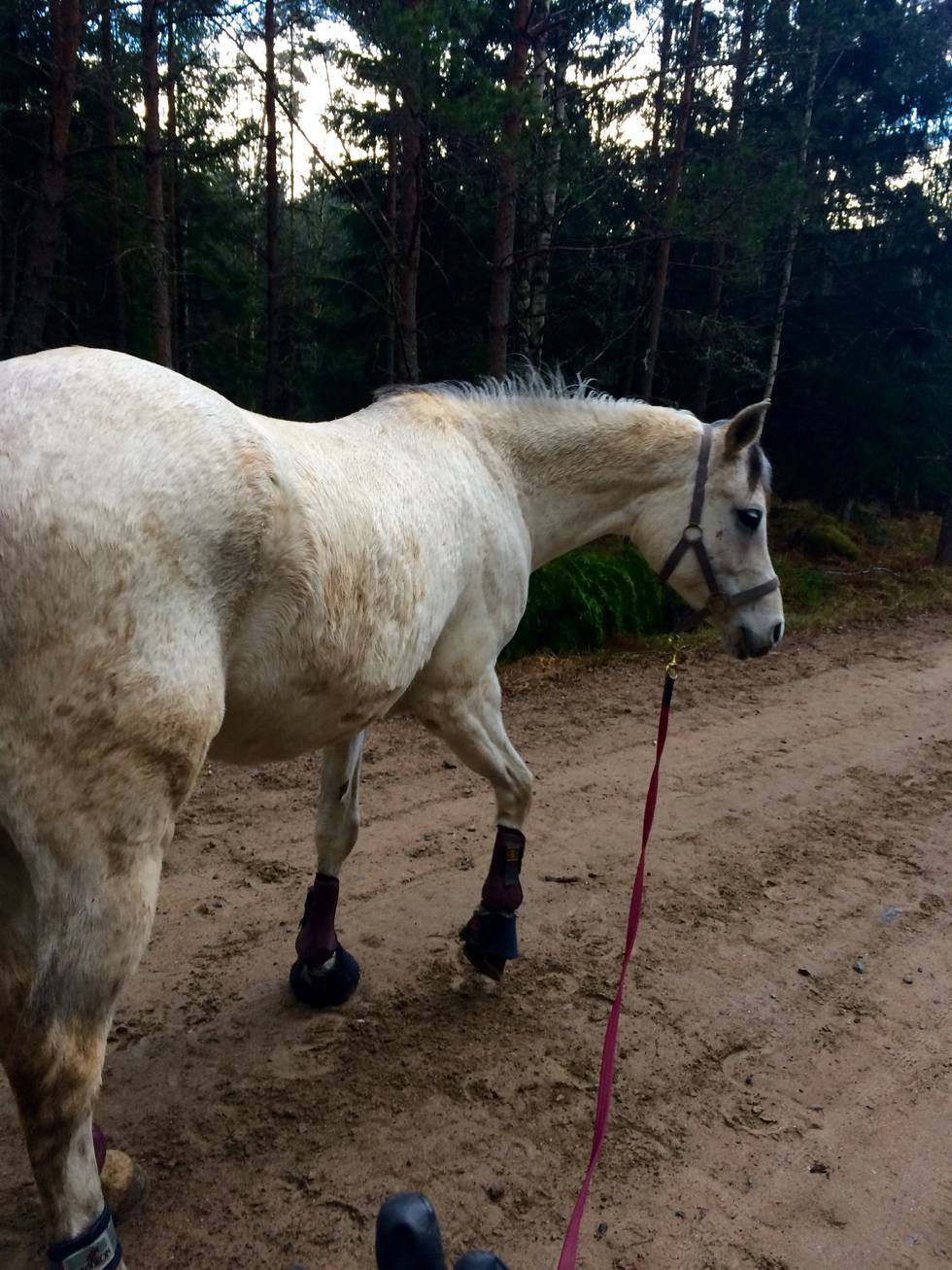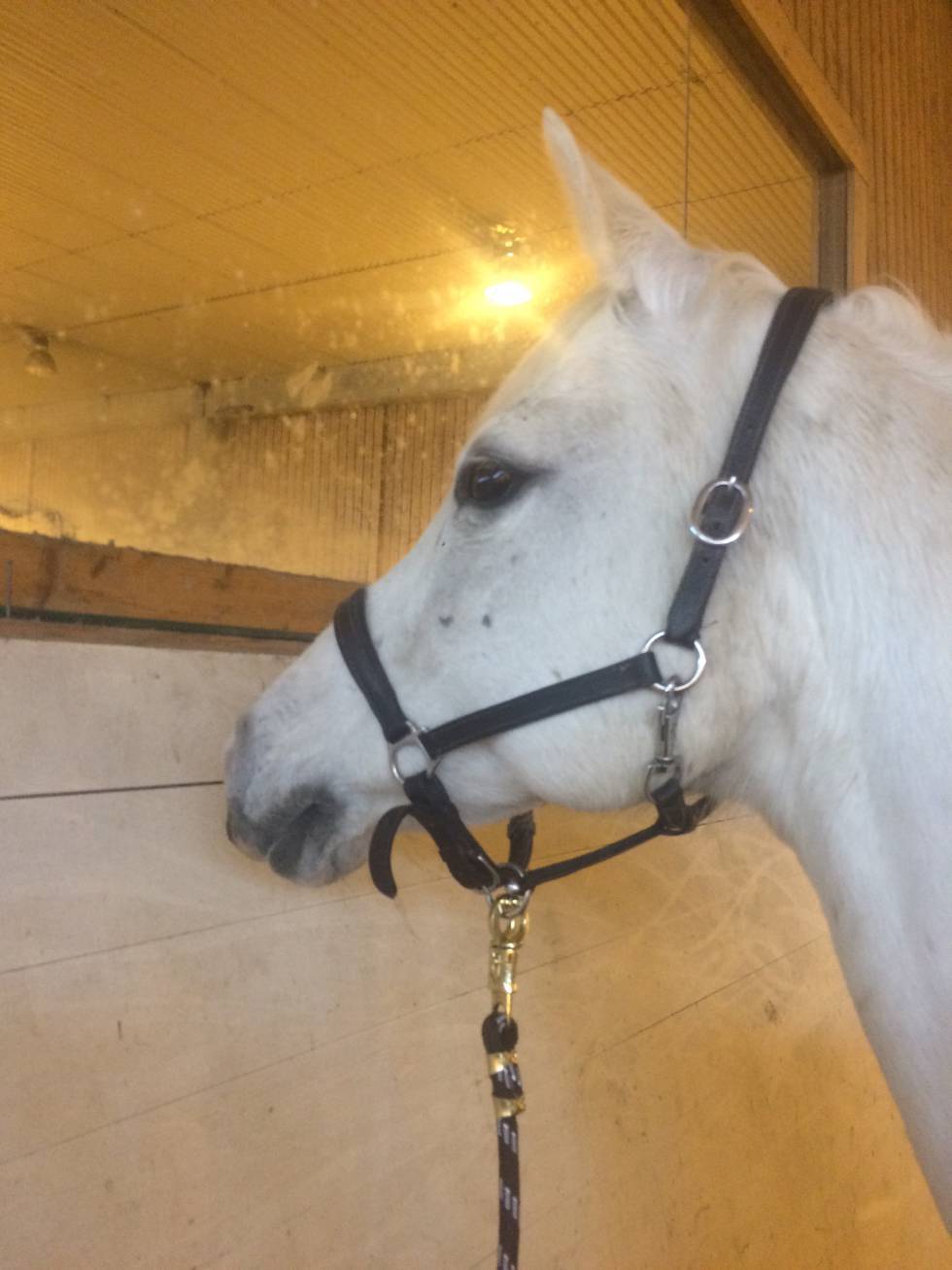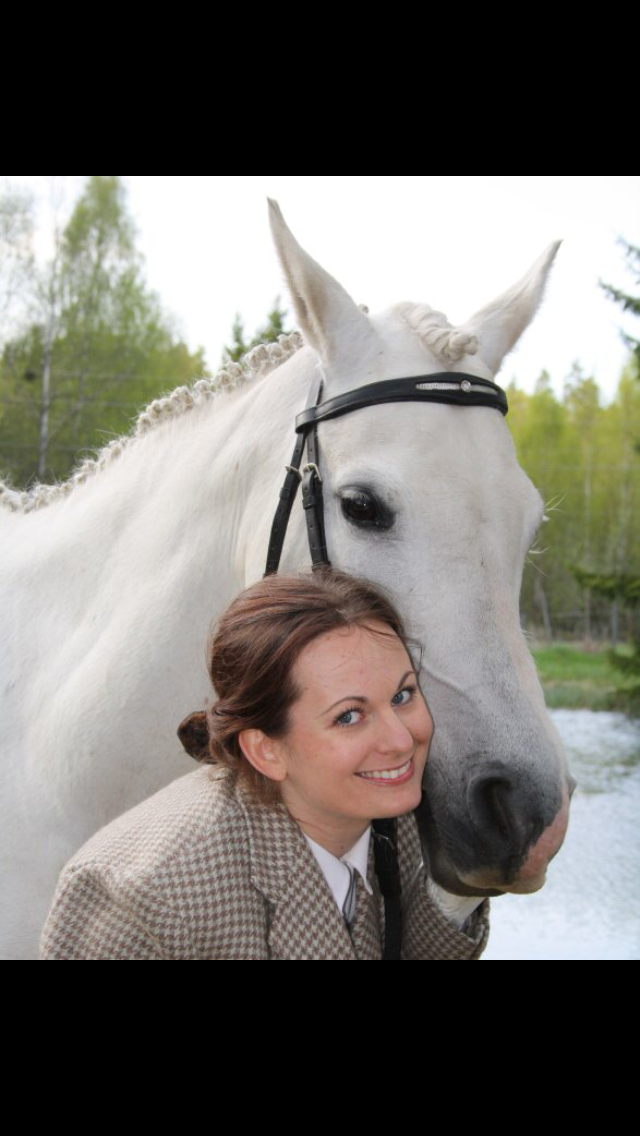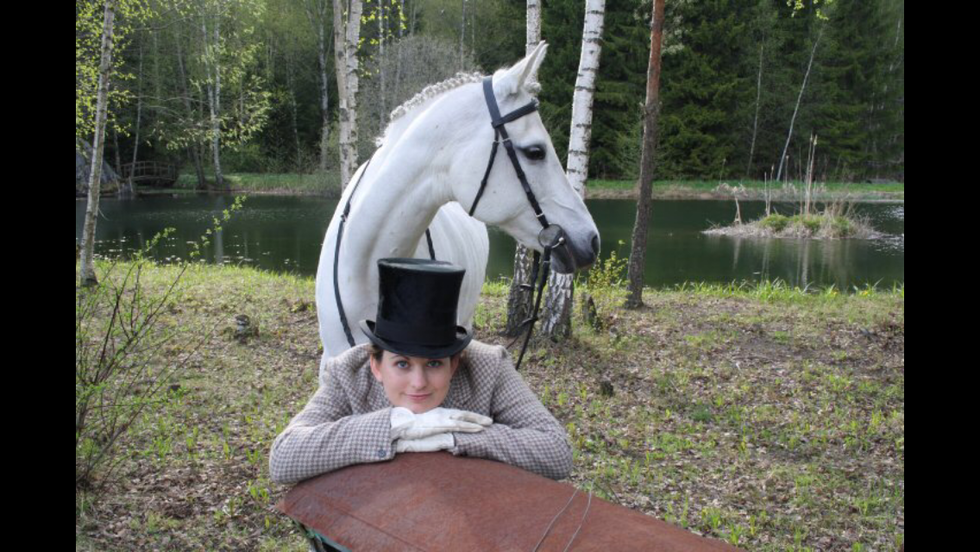
Credit: PhelpsPhotos.com
Ingrid Klimke poses with her father, the late Dr. Reiner Klimke, in 1999.
Often one hears riders in whatever discipline say that their aim is to bring the horse to a certain level or to place highly at certain shows. These goals are absolutely legitimate, but we must not forget that they are only a byproduct of what should be our highest of aims: To make our horses more beautiful and keep them healthy through their training.
Of course, my father, the late Dr. Reiner Klimke, always strived for Olympic glory, but he was well aware that he would not reach this goal if he took shortcuts. He knew it was better to wait rather than to rush a horse’s training. He taught me to be aware of the individual horse’s conformation and mind because we want to keep him healthy while he works. And to do that, we have to consider his conformation and any weaknesses there as well as his unique personality because keeping the horse healthy is only possible when we are aware that his body and soul work together and cannot be separated.
No matter if my father was training a very young horse, an eventer or a high-performance dressage horse, his training was always based on three principles:
• Keep variety in the training.
• Take small steps.
• Foster the horse’s personality.
Whatever he did, he would have these in mind, and he instilled them in me.

Credit: Silke Rottermann
Klimke rides Dresden Mann and works with trainer Morten Thomsen.
Variety in Training
To keep horses healthy, it was of uppermost importance to my father to offer a training program that developed the musculature and kept them happy and motivated in their work. Having been an internationally successful event rider, my father knew about the positive effects of cavalletti work for developing strength and keeping horses entertained. All his dressage horses did it and so do my horses today (see “How to Use Cavalletti,” p. 32).
There is work over cavalletti in different ways, hacking alone or in company and galloping on the hill to increase fitness. All my horses do this, no matter if it is my Olympic champion, Abraxxas (Hanoverian by Heraldik owned by Madeleine Winter-Schulze) or my Grand Prix horse, Liostro (Hanoverian by Le Primeur owned by the Opländer family).
I don’t shy away from asking my dressage horses to jump at least small poles at home. It is another way of putting variety into the training program, and most horses enjoy it tremendously once the ice is broken. This was demonstrated when my upcoming Grand Prix horse, Dresden Mann (Westfalian by Dresemann owned by Clodagh Wallace), showed his joy of jumping at the recent 2012 Global Dressage Forum.
Whatever I am working on—dressage or eventing skills—the essential parts of the training are the same. My father set the example and showed me the importance of a versatile approach that keeps horses physically and mentally fresh for a long time. To train a horse to the highest levels is already a big challenge, but to keep that standard over the years is another art in itself.
Sometimes varying the training is the only way to bring a wound-up, tense horse back to normal and, as a consequence, make full use of his abilities again. The Grand Prix dressage horse that was a classic example of this was the Belgian gelding Nector van het Carelshof (by Randel Z owned by Fiona Bigwood). When I got him in the spring of 2001, he could already do all the Grand Prix movements, but I couldn’t ask him to do them because he was extremely nervous. So I decided to train Nector like an event horse to settle his nerves and work on his relaxation. We stabled him in a stall with a small paddock. He was turned out in the field, worked over cavalletti and hacked in the forests. The first four months I was still skeptical whether or not I could get him to trust me and reduce his tension.
A swish in the bush made him sweat, and I could not ride him forward and downward. Then I started jumping him, first at home and then cross-country, to strengthen his self-confidence. Still, it took me a year until he gave me the feeling that he trusted me and would focus on me. I continued with the varying training, and after another several months, he had complete faith in me. That year, we qualified for the World Cup Final, where we placed eighth. During my baby break, Nector just did a relaxing program, and when I was back on board, he gave me the feeling that he really had come into his own, nearly two years after I got him.

Credit: Silke Rottermann
Klimke warms up Dresden Mann before a Intermediaire I test with a lot of stretching of the topline.Take Small Steps
We must not forget that whatever we do and whatever we ask our horses in the daily training, it is our responsibility. We are responsible for the horse’s well-being. We have to think about it day by day and make readjustments, when necessary. We absolutely have to empathize with our horse and try to make decisions in his best interest. It is good and necessary to set goals and make plans, but my father taught me that, in the end, it is the horse that sets the schedule. Whatever we teach the horse, we must do it by going step by step—small steps, not big ones.
Sometimes riders just forget that when a horse learns new things, he might easily be able to cope with the demands physically, but he also needs appropriate time to take them in mentally. So after teaching my horses a new exercise and, after they do it well, I always allow them to rest and do something different for the next few days. This gives them time to think about it and understand. With very young horses, we turn them out in a field for a longer time after they have mastered an important step in their training. With older, more-advanced horses, some quieter days may be enough before we come back to the recently learned things.
By taking small steps and allowing the horse to understand each of them, we respect his personality. A horse that is never asked too much at once and is given time to really learn and understand is a horse that feels loved by his rider and this subsequently increases his self-confidence. Taking small steps should be the main principle of any horse’s training, but it is even more indispensable when you have a highly talented horse that offers everything every day.

Credit: Silke Rottermann
She includes riding in a half seat at canter.Such a horse was the Westfalian stallion Damon Hill (by Donnerhall owned by Christian Becks). I got him as a 3-year-old. This horse was an incredibly quick learner, highly talented and extremely cooperative. Each day he came out of his stall asking, What are we doing today? I had to slow him down and distract him by varying his training a lot.
The horse type we have nowadays—very willing, cooperative and sound in mind—is tempting to a rider. But we have to bear in mind that a rider’s aim should not be to reach a certain level as quickly as possible but to keep the horse healthy throughout our training.
Damon Hill could have reached Grand Prix a year earlier, but his health might not have kept up with that. So one winter, we just kept him happy and motivated by hacking, jumping and riding in the field. That way, he progressed in small steps but was not bored and never lost his eagerness to learn. We can still see this attitude today as he continues improving with his new rider, Helen Langehanenberg (2012 German Olympic team members).
Foster the Horse’s Personality
For my father, there was a close and inseparable connection between the right training and the development of a horse’s personality. He always, rightly, used to say: “We not only need to strengthen the muscles but, in particular, the personality of the horse.” What we want as riders are self-confident horses that are reliable and attentive but also ones that love to show off in a positive way. This is particularly valid for dressage, where such expression earns us higher marks.
My father’s most famous and successful dressage horse was the Westfalian gelding Ahlerich. He was a good example of the “Here I am” expression my father looked for in his horses. If the right training has taken the horse to the point where he feels strong and masters the tasks with ease, it will feel delightful to work with us and show himself to the world. Many remember Ahlerich’s exuberance at the 1984 Olympics in Los Angeles, where the pair won the individual gold medal and performed 75 consecutive one-tempi changes during the victory lap.
Sometimes to foster a horse’s personality also means to accept that we can influence but never dominate him. We have to find subtle ways to control exuberant horses. The first that comes to my mind is Dresden Mann. When I got him—a just-backed horse and a licensed stallion—he was very strong-minded and really dominant. He was not so much fixed on mares as he was on other stallions, which he strongly considered his rivals. Though I never felt unsafe on him, in hindsight there had been a few rather dangerous situations when warming him up at shows with other stallions in the ring. As a result, Alfi, as we nicknamed him, often had problems focusing on me.
First, we just tried to avoid tricky situations. Then we worked with a renowned German horsemanship trainer, but Alfi just did not give in. He controlled us rather than let us control him. Finally, we realized that to struggle with him was useless. Luckily, his owners agreed to geld him and the situation improved. Since then, Alfi won both classes at CDN Münster in his Grand Prix debut.

Credit: Silke Rottermann
Klimke pilots Escada over a chair!A Word on the Rider
I cannot finish this piece without mentioning that, although for my father the horse was of greatest importance, he also knew how important the rider is for the horse. To do the horse justice, the rider also needs breaks to regain energy and focus. Keep this in mind if you are working with horses, and don’t hesitate to allow yourself a break if you feel you need it. Small but effective breaks are often beneficial before an important class at a show. My father always used to retreat at shows with a towel over his head to separate him from the world outside and to let him focus in the darkness on the program lying ahead. I am a bit luckier today having the possibility to retreat in the living quarters of my truck to focus on the task ahead. I sit there with my eyes closed and completely focus on what lies in front of my horse and me.
At the Olympic Games in London last year, a special situation occurred in which I could profit from my experience and gift to concentrate. When a horse broke loose on the cross-country course, my starting time was delayed for one hour. At the time, I didn’t know exactly for how long it would be, so I told myself to stay calm and focused and not to make myself crazy. To do this, I retreated into the stall of my horse, Butts Abraxxas, and talked him through the course again. He laid his head on my shoulder, as he is very cuddly, and so we spent a very intensive time together absolutely on our own before we finally could start our cross-country round, which became one of the best he has ever given me.

Ruth KlimkeThe Matriarch of a Riding Family
By Ruth Klimke
Ingrid and her brothers, Michael and Rolf, all began riding on a gray Connemara mare. When they were a bit more advanced, my husband, Reiner, and I found two safe German Riding Ponies from Gina and Nadine Capellmann. Of course, we taught them the basics in the beginning and helped them at their first small shows. It was natural for us that our children would ride, but we never forced them to do anything or pushed them, and whereas Ingrid and Michael continued riding, Rolf just stopped one day.
When Ingrid was older, her father rode early in the morning when she was still at school, and when she rode in the afternoon, he worked in his law practice. But they still managed to talk things over almost daily. Ingrid would make appointments with her father if she had a special problem, a question or wanted to show him something.
Ingrid was easy to work with. She was always interested and listened and tried to implement advice. My husband was a role model for her, but she also tried new things on her own and made her own experiences on the basis of what we taught.
Today, Ingrid practices what I call a “holistic approach.” Her training includes elements of natural horsemanship and modern sports therapy, such as physiotherapy and acupuncture to increase a horse’s well-being and fitness.
As a mother, I am terribly proud of my daughter and of what she has achieved together with her horses. Of course, the Olympic Games have always been something special to our family. My husband only thought and planned in four-year terms. That Ingrid had the opportunity to take part in four Olympic Games in succession makes me happy and grateful. It makes me even happier that she continues training and riding in the tradition of my husband and keeps it alive in our times.

Credit: Silke Rottermann
Klimke schools her Grand Prix horse Dresden Mann over cavalletti.How to Use Cavalletti In Walk, Trot & Canter
My father had a systematic approach to cavalletti work in the daily training of all his horses for eventing or dressage, younger or older. He wrote his experiences down decades ago in the bookCavalletti Work. I continue this tradition with my own horses and am convinced that it can benefit all horses. The advantages include fostering the horse’s concentration, improving his motivation for all work and suppling and strengthening his muscles. Here’s what you have to pay attention to:
Use the correct cavalletti: To effectively and safely practice, simple poles lying on the ground are not enough. They can be dangerous if the horse steps on one. Ideally, use cavalletti that allow you to vary the height. These are needed for the work in the different gaits. The poles should be about 2 to 3 meters long (one meter is 3 feet, 3 inches) and be thick and solid enough so the horse respects them.
Practice regularly: Cavalletti work is demanding and needs regular practice. Try to include it in your daily work at least three times a week, but don’t make the sessions lengthy.
Height and distances: Usually, I use four cavalletti in a row on a straight or curved line. The actual height and distances need to match the needs of your horse. Generally, in walk I use the cavalletti placed at the lowest height, about 20 centimeters (8 inches). The distance between each cavalletti is about 80 cm (3 feet). In trot, I put the cavalletti to a height of about 30 cm (1 foot) and the distance is about 130 cm (4 feet, 3 inches). In canter, the cavalletti are erected to a height of 50 cm (1½ feet) and the distance should be about 3½ meters (about 11 feet). Do not use cavalletti lying on the ground for trot or canter work as the horse may not respect them and stumble.
During the warm-up phase and in walk: The warm-up phase is most important because, if it is not successful, the working phase that follows cannot be successful either. To help the horse settle, I always start by walking him on completely loose reins. If this is not possible, take the reins as long as you can. If your horse is still tense, do not mind, just prolong this phase.
Walk your horse with long reins with a soft contact over a row of cavalletti set in a straight line. Pay attention and approach the first one straight and continue this line, otherwise the distance changes and the horse loses his rhythm. Slightly follow your horse’s movement over the poles with your upper body. To use cavalletti in the warm-up phase is ideal to activate the horse’s hind legs and animate an arching back, which would otherwise not be possible during this first phase of the daily training.
In dressage, the extended walk is a demanding movement as it requires relaxation, lengthening of the strides and a stretched topline. With cavalletti work you can ideally train all these requirements by lengthening the distances between the single cavalletti from 80 cm to about 1 meter during the working phase. As soon as your horse approaches the first pole, allow him to chew the reins out of your hands to be able to really stretch. Though this is an effective exercise, don’t overuse it as it is quite demanding on the horse physically. So use it regularly but not for too long in one session.
Trot and canter: You can also work on the lengthening of your horse’s strides in trot. The distance between the single poles has to be changed from 130 to about 150 cm (about 5 feet). Approach the row of cavalletti straight and in rising trot. Keep your horse in a soft contact. A few steps before the first pole, steadily increase the tempo to have sufficient impulsion. Take care to keep the horse in a steady rhythm, otherwise he might break into canter. Don’t practice this too often during only one lesson.
At first, to include cavalletti in the canter work of dressage horses might look less effective. Still, it trains the hind legs of the horse in a good way, which is of advantage for the collected work. This way, the inner hind leg is activated to come more under the horse’s center of gravity. Take care that the cavalletti are about 50 cm (1½ feet), otherwise the horses just become faster.

Credit: Dirk Caremans
Ingrid Klimke is a double Olympic eventing champion and a successful international Young Horse and Grand Prix dressage competitor. Her father is the late Dr. Reiner Klimke, who was an Olympic dressage champion with six gold and two bronze medals. Ingrid lives with husband, Andreas Busacker, and their two children near Münster, Germany.



























